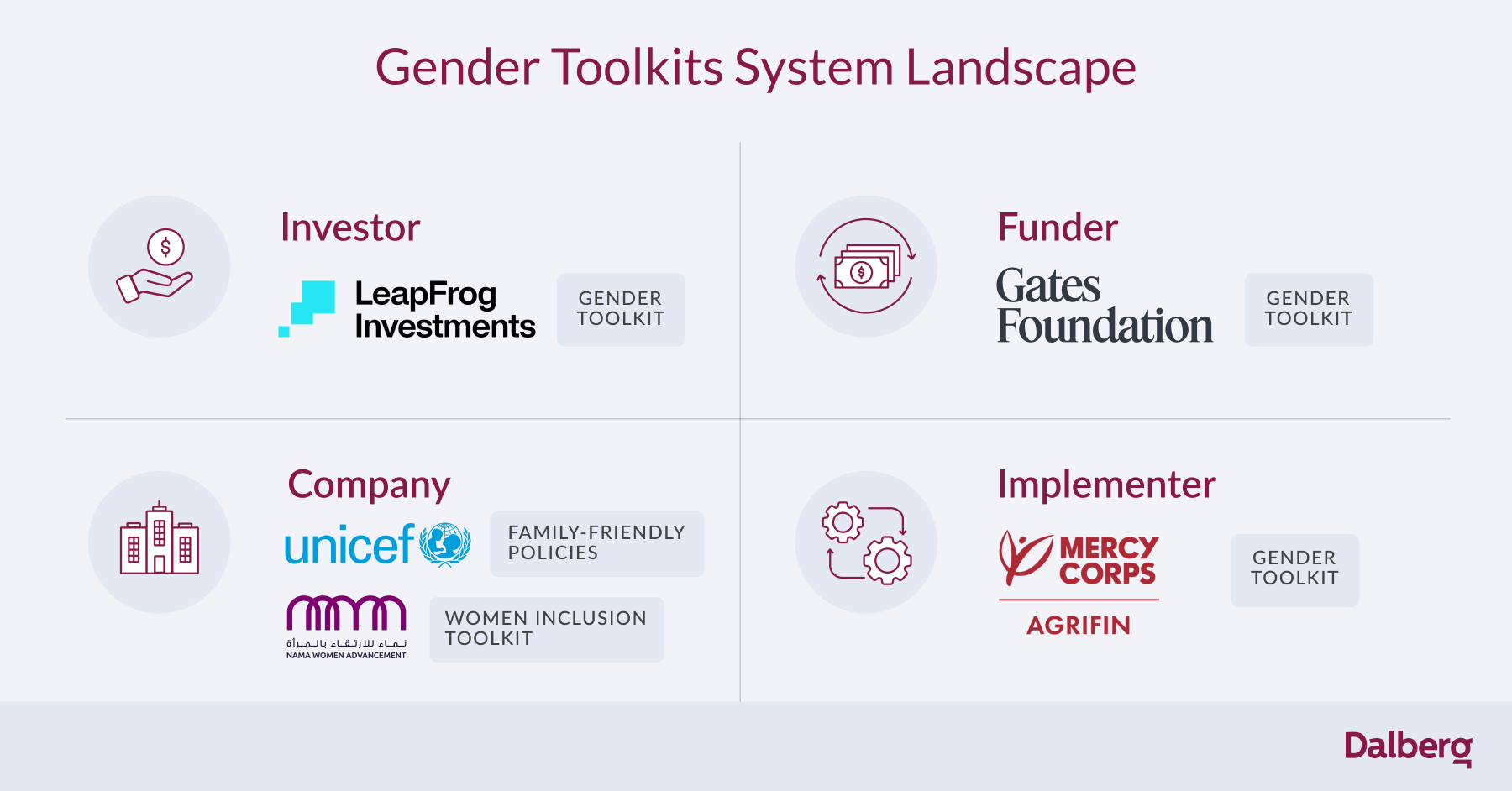Dalberg uses cookies and related technologies to improve the way the site functions. A cookie is a text file that is stored on your device. We use these text files for functionality such as to analyze our traffic or to personalize content. You can easily control how we use cookies on your device by adjusting the settings below, and you may also change those settings at any time by visiting our privacy policy page.
When women have equal opportunities to thrive, it fuels progress, drives innovation, and creates shared prosperity. Organizations that promote gender equality—through inclusive leadership and equitable opportunities for women to shape operations and decisions—can unlock the full potential of their workforce. Research shows powerful ripple effects, from higher productivity and better products and services to increased appeal for investment.[1] Despite these benefits, many organizations struggle to translate intention into action. They often lack clear, context-specific pathways to integrate gender equity into their work.
The Role of Gender Toolkits
Gender toolkits help organizations put gender equality into practice across their plans, daily work, and culture. These toolkits can help:
- Assess the starting point – through diagnostic tools, surveys, and baseline assessments to identify gaps in existing efforts, as well as untapped opportunities.
- Identify practical steps – based on context-specific best practices and case studies, lay out the next steps to move from an abstract goal towards tangible progress.
- Track progress – through clear indicators and feedback loops around what works and does not.
There are a growing number of gender-focused toolkits that help organizations to improve gender equity within their organizations and in the products and services they offer. At Dalberg, we have seen that customizing them to the specific needs of each organization, geography, and sector makes them significantly more effective. What “good” looks like can vary widely depending on an organization’s stage of growth, geography, and sector. For example, micro, small, and medium enterprises (MSMEs) often operate with limited resources and capacity, requiring more streamlined tools. In contrast, larger organizations may benefit from more comprehensive frameworks. Similarly, what defines success in gender equity can differ—financial services may prioritize inclusive product design and access, while manufacturing may focus on equitable workplace policies. NGOs, unlike private companies, are typically optimizing for social impact over profit, which shifts the kinds of metrics and insights that are most relevant. Tailored toolkits that prioritize the most relevant and actionable insights for each context are easier to use, more directly relevant, and more likely to be implemented. Below, we outline how these resources—especially customized ones—can help different actors drive gender equity and achieve deeper impact.
For Investors and Funders: Embedding Gender in Funding Allocations
Gender toolkits offer a shared framework for investors and their partners—whether for portfolio companies or grantees—to identify gaps in current gender efforts, assess whether resources are being used effectively, and offer recommendations on how to strengthen integration across funders and implementing partners.
Toolkits support investors and funders to:
- Scale funding to advance gender-focused outcomes – by mapping whether resources are being directed towards partners and initiatives that promote gender equity.
- Strengthen partner and investee capacity to integrate gender considerations – by providing partners with concrete recommendations to address identified gaps and a means of tracking their progress over time. This guidance can be particularly helpful for partners who lack expertise, or struggle with identifying how to get started.
- Encourage other partners, investors, and funders to apply a gender lens through leadership – by aligning your screening process with industry-wide standards and thus enhancing overall usage and understanding of these standards
Dalberg has supported a range of organizations in developing customized gender toolkits. We developed a toolkit to help LeapFrog Investments assess and monitor progress toward gender goals across its portfolio companies, including commitments under a 2X Flagship Fund. This resource also identifies areas where additional support may be needed. Similarly, Dalberg worked with the Gates Foundation to design an assessment framework for program officers, aimed at aligning funding decisions with the primary barriers women farmers face along the agricultural value chain—such as limited voice, restricted access and control over resources, and constrained networks.
For Companies and Implementers: Integrating Gender Equity across Business Areas and Programs
For businesses and implementers, gender toolkits help evaluate gender policies and practices across strategic and operational areas, from internal policies to product design. Whether just beginning their journey or seeking to deepen existing work, organizations can use these guides to offer clear guidance on when, why, and how to implement key gender initiatives. If you are just beginning your gender equity journey, toolkits can help you prioritize which gender initiatives are the most impactful, but also feasible.
Toolkits support companies and implementers to:
- Create inclusive workplaces – by implementing HR policies and practices that advance women’s career progression and leadership opportunities.
- Design gender-responsive products and services – by identifying and addressing gender-based barriers in access and usage to meet the needs of women and girls across income levels and contexts.
- Promote workplace safety and equity – by mitigating risks related to gender-based discrimination, harassment, and unequal pay.
Gender toolkits can help advance workplace equity across various industries and settings. In partnership with UNICEF, Dalberg created the Family-Friendly Policies Toolkit, which equips businesses—factories, farms, offices, and service-based organizations—to integrate policies such as paid leave, flexible work and childcare support tailored to their unique operational needs. Dalberg also designed a gender transformation toolkit for Mercy Corps Agrifin Accelerate to support farmer-facing organizations in developing more effective and inclusive products, services, business models, and partnerships for women smallholder farmers to fully benefit and participate in the agricultural market. Within the Middle East and North Africa (MENA) region, our Women’s Inclusion Toolkit for NAMA Women Advancement supports companies in understanding best practices to close gender gaps across their operations.

Beyond the Toolkit: Embedding Gender Equity into Culture and Innovation
Gender toolkits do more than provide an assessment framework, a roadmap or list of next steps – they spark conversations about the underlying structures that sustain gender inequities and the value of addressing them. These discussions are necessary to generate buy-in across an organization. By encouraging teams to ask, “Why are things the way they are?” and “What is the value of changing them?” gender toolkits build a culture of reflection, learning and accountability, laying the groundwork for meaningful change.
Our experience shows that gender toolkits are not a one-size-fits-all solution. They are most effective when paired with leadership engagement, resources for implementation and in some cases, complementary tools, including those that simplify implementation or drive behavioral change. Customized gender toolkits help move organizations from intention to action. They are practical, adaptable, and proven to increase the likelihood of uptake and meaningful impact. Whether deploying capital, managing teams, or designing services, these resources can act as powerful enablers of gender equity.
[1] ILO, Women in Business and Management: The Business Case for Change (2019); Morgan Stanley, Sustainable Signals: Understanding Individual Investors’ Interests and Priorities (2024); Chikwe et al., Advancing gender equality through strategic project management: A framework for integrating gender-responsive policies in development projects (2024)
Download the Family Friendly Policies toolkit from UNICEF to learn how workplace policies can support gender equity
To learn more or explore how a toolkit could support organizational goals, reach out to:




